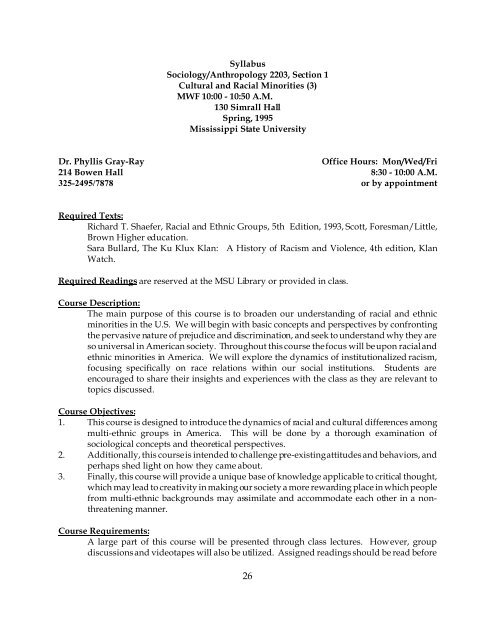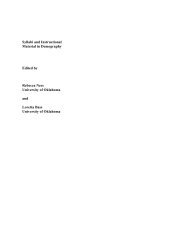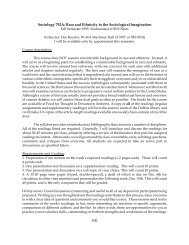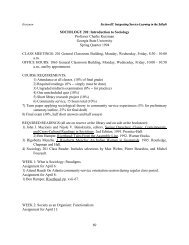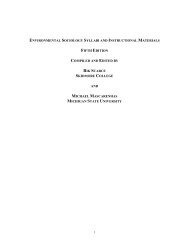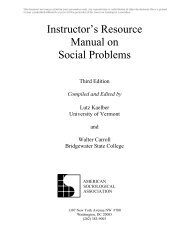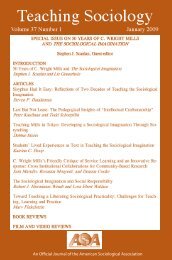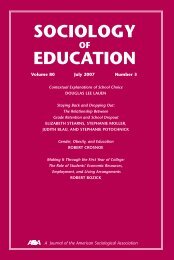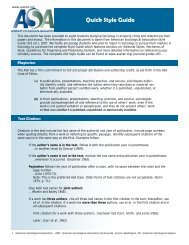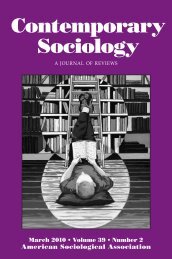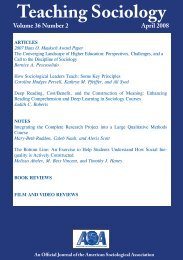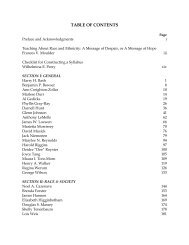Phyllis Gray-Ray - American Sociological Association
Phyllis Gray-Ray - American Sociological Association
Phyllis Gray-Ray - American Sociological Association
Create successful ePaper yourself
Turn your PDF publications into a flip-book with our unique Google optimized e-Paper software.
Syllabus<br />
Sociology/Anthropology 2203, Section 1<br />
Cultural and Racial Minorities (3)<br />
MWF 10:00 - 10:50 A.M.<br />
130 Simrall Hall<br />
Spring, 1995<br />
Mississippi State University<br />
Dr. <strong>Phyllis</strong> <strong>Gray</strong>-<strong>Ray</strong> Office Hours: Mon/Wed/Fri<br />
214 Bowen Hall 8:30 - 10:00 A.M.<br />
325-2495/7878 or by appointment<br />
Required Texts:<br />
Richard T. Shaefer, Racial and Ethnic Groups, 5th Edition, 1993, Scott, Foresman/Little,<br />
Brown Higher education.<br />
Sara Bullard, The Ku Klux Klan: A History of Racism and Violence, 4th edition, Klan<br />
Watch.<br />
Required Readings are reserved at the MSU Library or provided in class.<br />
Course Description:<br />
The main purpose of this course is to broaden our understanding of racial and ethnic<br />
minorities in the U.S. We will begin with basic concepts and perspectives by confronting<br />
the pervasive nature of prejudice and discrimination, and seek to understand why they are<br />
so universal in <strong>American</strong> society. Throughout this course the focus will be upon racial and<br />
ethnic minorities in America. We will explore the dynamics of institutionalized racism,<br />
focusing specifically on race relations within our social institutions. Students are<br />
encouraged to share their insights and experiences with the class as they are relevant to<br />
topics discussed.<br />
Course Objectives:<br />
1. This course is designed to introduce the dynamics of racial and cultural differences among<br />
multi-ethnic groups in America. This will be done by a thorough examination of<br />
sociological concepts and theoretical perspectives.<br />
2. Additionally, this course is intended to challenge pre-existing attitudes and behaviors, and<br />
perhaps shed light on how they came about.<br />
3. Finally, this course will provide a unique base of knowledge applicable to critical thought,<br />
which may lead to creativity in making our society a more rewarding place in which people<br />
from multi-ethnic backgrounds may assimilate and accommodate each other in a nonthreatening<br />
manner.<br />
Course Requirements:<br />
A large part of this course will be presented through class lectures. However, group<br />
discussions and videotapes will also be utilized. Assigned readings should be read before<br />
26
coming to class. Students are encouraged to attend and participate in all class sessions.<br />
Excessive absences and tardiness are highly discouraged. Attendance is needed to get the<br />
full benefits from this course. Students should feel free to report any current event relevant<br />
to Cultural and Racial Minorities.<br />
Examinations:<br />
There will be three exams throughout the semester. Exams will cover lectures, required<br />
readings, videotapes and textbook chapters. Students who plan to miss tests because of<br />
school activities must request special arrangements before the test date.<br />
Projects, activities and assignments:<br />
Projects, activities and assignments will be due throughout the semester. Separate<br />
handouts with detailed instructions will be distributed in class. Important: In- class<br />
activities or assignments cannot be made up.<br />
Videotapes:<br />
Selected videotapes from the attached listing will be shown throughout the semester.<br />
These tapes are a critical part of the course. The intent is to enhance students<br />
understanding of the sociological concepts discussed. Students are encouraged to take<br />
notes.<br />
Grading:<br />
Items Points Scale<br />
3 exams 20 @ 60 A=90-l00<br />
Major Project 20 B=80-89<br />
Activities and Assignments 20 C=70-79<br />
TOTAL 100 D=60-69<br />
F=below 60<br />
27
Tentative Outline<br />
Dates Topics Assignments<br />
Jan. 9-13 Introduction Syllabus/Social Distance Ex.<br />
Jan. 18-25 Concepts & Chapters 1, 16, 17<br />
Perspectives<br />
Jan. 27-Feb. 3 Race Relations Chapters 2 & 3<br />
Feb. 6-l0 White <strong>American</strong>s Chapters 4, 5, 15<br />
Feb. 13 Exam I<br />
Feb. 15-Mar. 10 Racial Minorities: Chapters 6, 7, 8<br />
Native <strong>American</strong>s<br />
African <strong>American</strong>s<br />
March 20-22 Class Activities<br />
March 24 Exam II<br />
Mar. 27-Apr. 12 Racial Minorities: Chapters 9, 10, 11<br />
Hispanic <strong>American</strong>s 12, 13, 14<br />
Asian <strong>American</strong>s<br />
April 17-28 Class Projects<br />
May 1-3 Class Activities<br />
May 5 Exam III (Final, 8:00-11:00 A.M.)<br />
Note: The instructor has the right to revise this tentative outline as necessary. Chapters<br />
are from the required textbook. Readings are from the reserved readings at the<br />
MSU Library or distributed in class.<br />
1. Racism in America<br />
2. Black on Black Violence<br />
3. Pockets of Hate<br />
4. The Asianization of America<br />
5. PR (Hispanics)<br />
6. Ethnic Notions (Stereotypes)<br />
7. Navajo Moon (Indians)<br />
VIDEOTAPES<br />
28
8. Mississippi Summer<br />
9. Klan: Legacy of Hate in America<br />
10. The Next Minority: White <strong>American</strong>s<br />
11. Selling of Jamie Thomas I<br />
12. Selling of Jamie Thomas II<br />
13. Michael Donald Lynching<br />
14. Eyes on the Prize Series:<br />
A. Awakenings (1954-1956)<br />
B. Fighting Back (1957-1962)<br />
C. Ain't Scared of Your Jails (1960-1961)<br />
D. No Easy Walk (1962-1966)<br />
E. Mississippi: Is this America? (1962-1964)<br />
F. Bridge to Freedom (1965)<br />
15. The Fall of <strong>American</strong> Educational System: Minister Louis Farrakhan<br />
16. The Morris Dees Story<br />
17. Golden Words: Dr. Martin Luther King, Jr.<br />
18. Roots Series<br />
19. Others<br />
Indicate your willingness to interact with members of particular groups in the following<br />
situations:<br />
1 = very willing; 2 = willing; 3 = somewhat willing; 4 = neutral<br />
5 = somewhat unwilling; 6 = unwilling; 7 = very unwilling<br />
1. Black <strong>American</strong>s<br />
As Close Kin by Marriage 1 2 3 4 5 6 7<br />
As Fellow Club M embers 1 2 3 4 5 6 7<br />
As Neighbors 1 2 3 4 5 6 7<br />
As Visitors to my Home 1 2 3 4 5 6 7<br />
As a Spouse 1 2 3 4 5 6 7<br />
As an Intimate Friend 1 2 3 4 5 6 7<br />
As a Step-Parent 1 2 3 4 5 6 7<br />
As Students 1 2 3 4 5 6 7<br />
2. Hispanic <strong>American</strong>s<br />
As Close Kin by Marriage 1 2 3 4 5 6 7<br />
As Fellow Club Members 1 2 3 4 5 6 7<br />
As Neighbors 1 2 3 4 5 6 7<br />
As Visitors to my Home 1 2 3 4 5 6 7<br />
As a Spouse 1 2 3 4 5 6 7<br />
As an Intimate Friend 1 2 3 4 5 6 7<br />
As a Step-Parent 1 2 3 4 5 6 7<br />
As Students 1 2 3 4 5 6 7<br />
3. Native <strong>American</strong>s<br />
As Close Kin by Marriage 1 2 3 4 5 6 7<br />
As Fellow Club Members 1 2 3 4 5 6 7<br />
As Neighbors 1 2 3 4 5 6 7<br />
29
As Visitors to my Home 1 2 3 4 5 6 7<br />
As a Spouse 1 2 3 4 5 6 7<br />
As an Intimate Friend 1 2 3 4 5 6 7<br />
As a Step-Parent 1 2 3 4 5 6 7<br />
As Students 1 2 3 4 5 6 7<br />
4. Asian <strong>American</strong>s<br />
As Close Kin by Marriage 1 2 3 4 5 6 7<br />
As Fellow Club Members 1 2 3 4 5 6 7<br />
As Neighbors 1 2 3 4 5 6 7<br />
As Visitors to my Home 1 2 3 4 5 6 7<br />
As a Spouse 1 2 3 4 5 6 7<br />
As an Intimate Friend 1 2 3 4 5 6 7<br />
As a Step-Parent 1 2 3 4 5 6 7<br />
As Students 1 2 3 4 5 6 7<br />
5. White <strong>American</strong>s<br />
As Close Kin by Marriage 1 2 3 4 5 6 7<br />
As Fellow Club Members 1 2 3 4 5 6 7<br />
As Neighbors 1 2 3 4 5 6 7<br />
As Visitors to my Home 1 2 3 4 5 6 7<br />
As a Spouse 1 2 3 4 5 6 7<br />
As an Intimate Friend 1 2 3 4 5 6 7<br />
As a Step-Parent 1 2 3 4 5 6 7<br />
As Students 1 2 3 4 5 6 7<br />
CULTURAL AND RACIAL MINORITIES<br />
MAJOR PROJECT<br />
SPRING 1995<br />
DR. PHYLLIS GRAY<br />
The major project for the course will be a creative component. This component will focus<br />
specifically on the most significant event in African <strong>American</strong> history since the Civil War and the<br />
ending of slavery--The Civil Rights Era. The component will be divided into three main elements.<br />
Students will work in pairs. (20 points)<br />
I. Introduction. Consists of an overview of the Civil Rights Era (1950s-1960s). Research and<br />
properly document this section. Be sure to explain why this is an important and significant<br />
event in <strong>American</strong> history.<br />
II. Case Studies (Biographical Sketches). Interview at least 10 people (5 black, 5 white) who<br />
experienced and remember the Civil Rights Era (1950s-1960s). In talking with these<br />
individuals, include questions on the following:<br />
1. Do not report names or direct addresses, but do state other demographic<br />
characteristics such as race, gender, age range, social class, occupations, education,<br />
and any other personal or background information that is appropriate.<br />
2. Race relations between blacks and whites in the South before and during the Civil<br />
30
Rights Movement.<br />
3. Racial etiquette (what was expected of each race, appropriate behaviors).<br />
4. Segregation in public life: Common carriers (i.e., buses), restaurants, theaters,<br />
schools, neighborhoods, etc.<br />
5. Equality and justice for blacks and whites.<br />
6. Examples of racial incidents that either they experienced or knew about involving<br />
someone else.<br />
7. Ask specific questions about the Emmet Till Case (see attached).<br />
8. Their perceptions of race relations in the South now and in the future.<br />
9. Any other questions that you would like to ask may be included.<br />
III. Discussion. Using your sociological imagination, summarize what you found and learned<br />
from this exercise. Be sure to demonstrate your knowledge of sociology by using concepts<br />
and perspectives in your discussion.<br />
The final project should be properly cited and referenced.<br />
1. Whenever you use someone's work, you must properly cite the work within the text<br />
(author's last name and year). For example: *note the underlined phrases. According to<br />
Alvin Poussaint (1986), black female-headed households are the most prevalent in the<br />
black community today.<br />
2. Projects must be researched using resources provided at the MSU library as well as others.<br />
At least a total of 5 references are required. *No footnotes*<br />
3. All references must be organized into a bibliography at the end of the project. The<br />
bibliography should be in the <strong>American</strong> <strong>Sociological</strong> <strong>Association</strong>'s (ASA) format. For<br />
example:<br />
(book)<br />
Herod, Augustina and Charles C. Herod. 1986. Afro-<strong>American</strong> Nationalism. New<br />
York: Garland Publishing.<br />
(Journal Article)<br />
Simons, Ronald L. and <strong>Phyllis</strong> A. <strong>Gray</strong>. 1989. "Perceived blocked opportunity as a<br />
cause of delinquency among Black, lower-class youth." Journal of Research in<br />
Crime and Delinquency 26 (1): 90-101.<br />
4. Projects should be typed, double-spaced with legible print.<br />
5. A title page is required.<br />
6. Projects will be presented in class on April 17-28. All projects will be due on the<br />
17th. Make a copy for yourselves if you so desire. The final copy will not be returned<br />
but will remain on file with the professor.<br />
7. One final copy should be submitted to the professor.<br />
8. There will be 6 presentations each day. Each will last 7 minutes.<br />
9. Presentations will begin promptly at 10:00 A.M. each day. Attendance is required for all<br />
presentations. If you are absent without a written, legitimate excuse, you will lose 5 points<br />
from your final project grade.<br />
31
CLASS EXERCISE<br />
List everything you always wanted to know about black/whites, but never had the opportunity<br />
to ask.<br />
32
List the stereotypes of minority or dominant group members that you have? Specify how you<br />
think they came about.<br />
Based on your perceptions, rank these problems in terms of severity in the U.S. With one (l)<br />
being least and ten (10) being most.<br />
Unemployment _______<br />
Crime _______<br />
Inflation _______<br />
Racism _______<br />
Energy _______<br />
Sexism _______<br />
Drugs _______<br />
Ageism _______<br />
Poverty _______<br />
AIDS _______<br />
33
Name five famous minority <strong>American</strong>s.<br />
1.<br />
2.<br />
3.<br />
4.<br />
5.<br />
Why did you select these five?<br />
34
Activities White<br />
males<br />
English<br />
Basketball<br />
College Prep.<br />
Study Group<br />
Sewing<br />
Vocational Prep.<br />
Football<br />
Dance<br />
Singing<br />
Math<br />
Track<br />
Cooking<br />
Computers<br />
Baseball<br />
Ballet<br />
PLEASE SELECT THE BEST GROUP FOR EACH ACTIVITY<br />
Black<br />
males<br />
Groups<br />
35<br />
White<br />
females<br />
Black<br />
females


